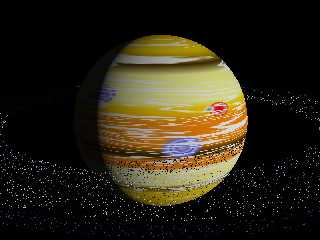|
 |
Hi Tracers!
I just can't refrain from inventing new planetary systems for
megalomaniac sci-fi scenarios intended to dwarf even the Dune Chronicles
one day ;-)))...
This here is Qais, a gas giant in the orange dwarf system Shams, also
known as DM +19 279 (the star really exists!), named after the
mythological ancestor of the Pashtuns - the system was colonized around
2360 AD by pioneers from Terran Afghanistan with has developed into a
spacefaring superpower during the 23th century... stop, stop, I only
want to deal with raytracing issues here!
And that's the problem: I want to place elliptical storm systems (like
Jupiter's Great Red Spot) above the planet's lower cloud deck, but
haven't found a way to avoid them showing up always in pairs - each
storm system has its antipodal counterpart. Is there any way to do this?
By the way, the scene is completely hand-coded... for the rings I used
not media (perhaps I better did...), but actually 400.000 small debris
objects - but, shame on me, just simple primitives scaled randomly,
I wish I could do this with more complex forms, and, of course, use MUCH
MUCH more (And smaller) ring particles...
See you in Khyberspace -
http://www.geocities.com/electricafghan/index-e.html
Yadgar
Post a reply to this message
Attachments:
Download 'qais.jpg' (115 KB)
Preview of image 'qais.jpg'

|
 |




![]()